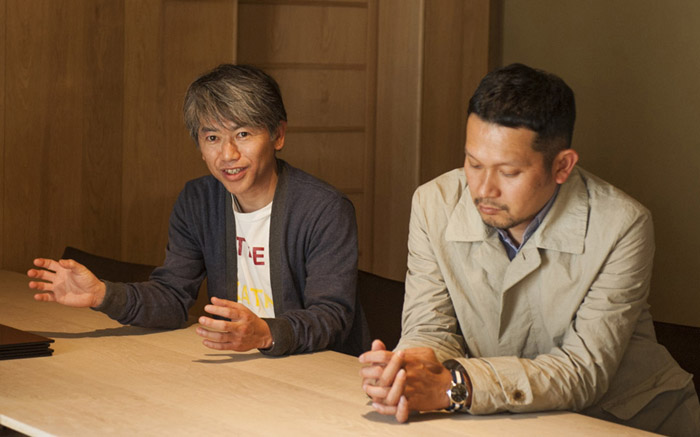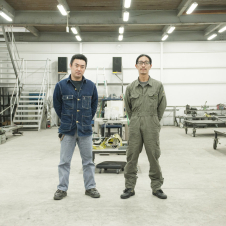One step forward
「鈴懸の空気」をデザインする。
Words by Kenji Jinnouchi, Photographs by Hiroshi Mizusaki,Edit by Masafumi Tada
Designing “Suzukake world”
Central – a new medium to communicate the everyday life of Fukuoka-based creative people working at home and abroad.
Suzukake Design Lab. has been supporting this platform since the launching.
On this Feature, our round table invited Narimasa Nakaoka of Suzukake Design Lab. and Suzukake (Japanese sweet maker in Fukuoka), Koichi Futatsumata (Case-Real) who is in charge of retail interior and space design of Suzukake stores, photographer Hiroshi Mizusaki (Loop photo creative) and Kensaku Iwashita who is in charge of Suzukake’s graphic design.
We caught a glimpse of the insights of the four leading the traditional establishment to a brand with a unique vision.
Central: Tell us how you got involved in Suzukake.
Mizusaki: I’ve been involved for the longest period of time amongst us. I had an opportunity to take still life photography of Suzukake’s okashi (Japanese sweet) when I went independent from a [photo] studio I used to work at.
Futatsumata: And apparently, one of my past architectural works was one of the photos Mizusaki-san showed Nakaoka-san, which he liked; that’s how we got to meet.
Nakaoka: That was a time when I was planning a branch in Isetan Shinjuku, which would have been the first store in Kanto area. Although it didn’t happen, I kept my eye on his works. I commissioned him in our main store project in Kamikawabata in 2008.
Mizusaki: To meet the opening of the main store, I was asked by Nakaoka-san if I know any good graphic designer and I introduced Iwashita-san whom I was looking forward to working with again.
Iwashita: (nodding.)

Central: What’s the process like in Suzukake project?
Futatsumata: Suzukake projects are a little bit unique; we take off from completely random conversations. That is, usual case follows this pattern from an “assignment” towards an “answer”, which might include one of these conversations: “Here is a request,” followed by “Ok, then what about this?” But in our case, we keep our normal conversation or chit-chat going like “Something like this would be good” or “I found this interesting thing.” As we continue this, it helps us to form images of a new store bit by bit and one day it reaches the critical mass where we go “[we’d] like to do this in the next store,” and then finally it starts moving as a project.
Mizusaki: The same goes to the photos. We don’t set a concrete concept but instead we have some vague theme. What we do is not the meeting before the photo-shoot, but is a work of expressing an ambience that was somehow communicated through our daily conversations without being clearly articulated. So, even when we have two days to shoot, we spend the first day to find and set the direction and could end up with only one shot in one day.
Nakaoka: But once it’s set, I keep my mouth shut, don’t I? (laughs)
Mizusaki: Exactly. (laughs) It was exactly like that when we did the new brochure and photos for the website. I kept hearing “Bring out the raw texture more.”
Nakaoka: Meals are given their own expressions such as “mouthwatering”, but more than anything, I wanted to bring out some tangible texture as if one can feel the wagashi sweet. Perhaps, it’s a world where you can imagine wagashi in the kitchen at someone’s home. That’s why we used not only ceramics but also urushi (lacquerware) and Imari plates that you can find at home. Although, if you ask me why that’s good, I can only answer that’s by my sense. (laughs)
Iwashita: The directions and ideas about where you want to lead Suzukake to are always spinning around in Nakaoka-san’s head, I think. I understand that my role is to realize them by sorting things out. The logo the store has now is the perfect example.
Nakaoka: Thinking about wagashi and Suzukake over and over led me to this answer that what represents the store, after all, is suzu (bell).
Iwashita: We had a series of discussions over the logo (overlapping silver and gold circles) with dozens of designs with different diameters and overlaps. Probably, the other people won’t notice these small differences. But, what we selected had the strongest representation.
Futatsumata: That is exactly what designing the ambience (kuuki wo tsukuru) is. It is not to work hard to do branding but to add a little bit of change. It is to get closer to Suzukake half a step ahead.


Central: The main store splits the space into sweet and tea sections. What was your thought behind this?
Futatsumata: Perhaps, it might be common to accommodate a wagashi showcase up front to the street and lay the tea space at the back. But I wanted to provide a quiet environment away from the street noise since the wagashi showcase is the most sacred place for this store. And at the same time, we also made some bespoke furniture such as chairs so the customers can sit back and relax in the tea area. The chair has a motif from the chair at Café Terrace Nakamura in Fukuoka City Museum. For a long time I’ve been admiring that chair – the width and the seat angle perfectly fit for the Japanese size – and I had no doubt when I received the commission for the main store.
Nakaoka: I know. You took me to the café saying, “Isn’t this chair comfortable?”
Futatsumata: The chair is a little too modern for a wagashi store, but I thought it was important to set a comfortable environment for the customers.
Nakaoka: Of course we care about wa (Japanese-ness) since we are a wagashi store, but that doesn’t mean we cement everything with Japanese items. Currently, we are thinking of installing some sort of yukimi shoji screen by the window of the tea area in the main store that cuts people’s glance from the street and sunshine; we haven’t finished the design yet and are thinking it’s fine as long as the complete ambience is something Japanese. That’s about it.
Futatsumata: In terms of the gap between the screens, the level of comfort [the screen can exert] ranges completely depending on, say, how much you can see people on the street between the screens. It could be one centimetre or millimetre. Nakaoka-san left everything with me and only asked to tell him the reason why I picked the length I picked. I have to say, he’s very talented to lead the creator, say, in a natural harmonious way.

Central: What does it mean for you all to be involved in creative works in Fukuoka?
Mizusaki: Born and grown up in Fukuoka, I think this is a place with full of things people take for granted including the distance to the nature and everything else and also the quality of foods. Of course, there are technical things not as convenient as in Tokyo but we have interesting companies such as Suzukake. Once you get used to work for companies like Suzukake, which requires some consulting elements as well from the creators, you tend to do this extra bit when working for other clients. For good and bad, I suppose.
Futatsumata: I came to Fukuoka for University and stayed since it fit me. Obviously, the number of opportunities in Tokyo doesn’t compare but I think that’s a different story from one’s own potential. Tokyo is a town where an enormous amount of information is constantly flowing, being compiled and polished. I receive inspiration [from them] but I don’t come up with ideas while I’m in Tokyo. It is at my office in Fukuoka that ideas spring to my mind from a fraction of memories in Tokyo. Perhaps, it is like you stir things in a water jar and wait until they fall at the bottom so you can see them clearly.
Nakaoka: I understand what you mean; I’m a native Hakata-man who carries Yamakasa. Perhaps the most important element for one to be himself is to be in the environment that suits him best.
Futatsumata: I also have to say that I want what we express to reach far outside of Fukuoka although we’re based in Fukuoka. I don’t think there is anything we cannot do because we are in Fukuoka; works and creations expand like a chemical reaction.
Iwashita: Since I got involved in this project, I started receiving inspirations from people around me and also enjoying the depth and gaps in monozukuri (craftsmanship). Whether the space and the calligraphy in the JR Hakata City store opened in April or new wrapping papers employed the modern patterns by Japanese painting artist Tomoyuki Kambe, I find some professional gaps off the design Suzukake had had.
Futatsumata: After all, there are many cases where correct solution is not what we create by majoring in design and constructing formal logic like a pyramid. At the very last stage of designing I was worried if the five-colour noren curtain at the main store’s entrance might create some mismatch feeling, but in retrospect I feel it was a necessary part of the store.
Nakaoka: It is boring for the creators to repeat the same routine all over, isn’t it? If we enjoy [what we do], the other end should be able to, too. Culture – wagashi as well – is part of our daily life; we want to take it seriously to have our customers enjoy it closely and casually and think how much richer [our creation] can have them feel.
Narimasa Nakaoka
Suzukake CEO (or President)
The third generation of traditional wagashi maker Suzukake, succeeding the heritage from the founder Saburo Nakaoka, who was awarded as the Contemporary Master Craftsman by Japanese Ministry of Labour.
http://www.suzukake.co.jp
Kensaku Iwashita
Graphic designer
Born in Fukuoka in 1969. Founded Iwashita Kensaku Design Office in 2000. Works in graphic design on print media as well as art direction.
Hiroshi Mizusaki
Photographer
Born in Fukuoka in 1970. Freelance from 2000. Works in still life to architecture photography.
www.loop-pc.jp
Koichi Futatsumata
Designer
Born in Kagoshima in 1975. Runs Case-Real and Koichi Futatsumata Studio. Works in interior, architecture, furniture and product design projects at home and abroad from Fukuoka and Tokyo.
http://www.casereal.com
http://www.futatsumata.com












